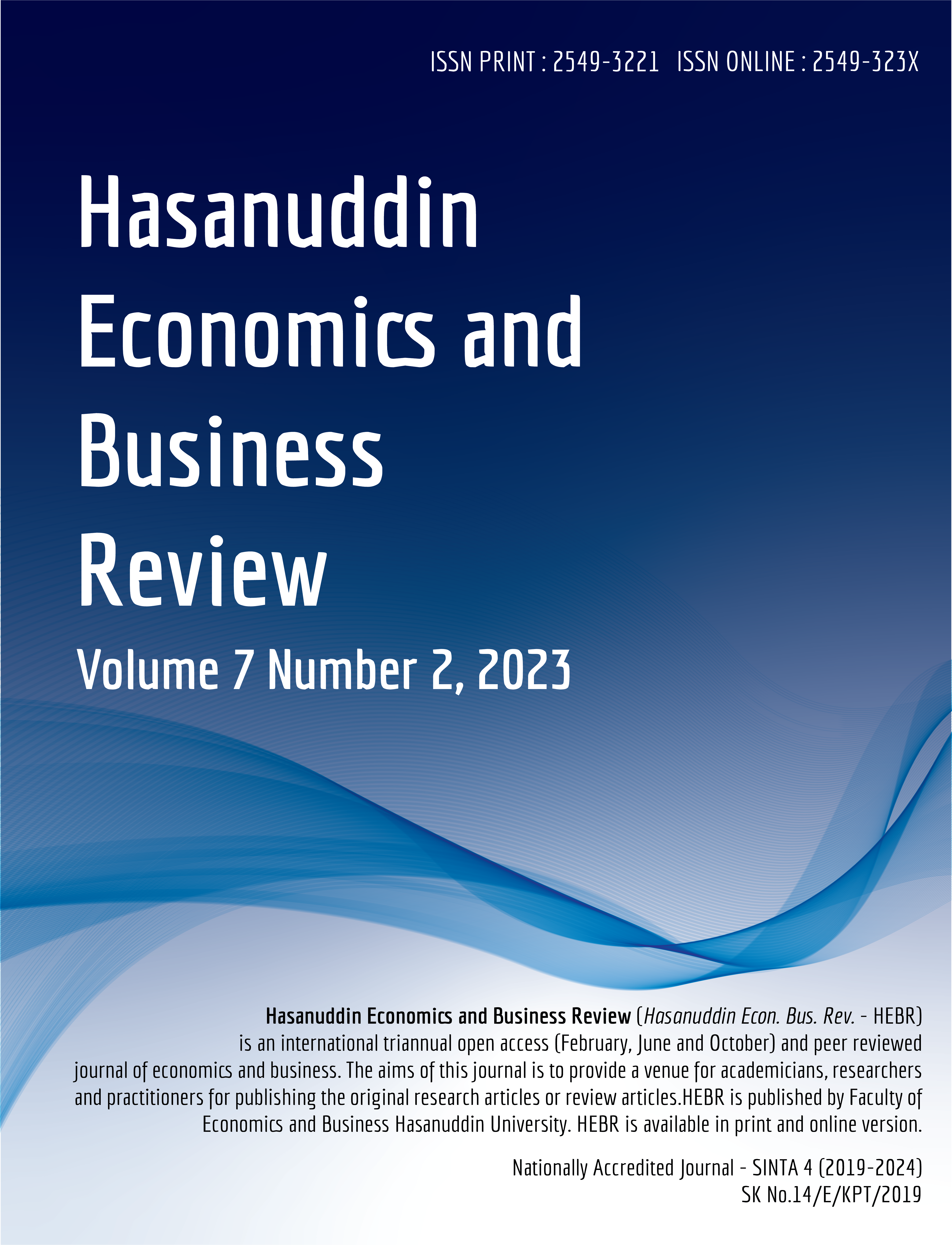Abstract
The purpose of this study is to examine and identify the factors that contribute to job mobility (changing jobs) among employees in Makassar City's informal sector. 100 respondents provided the primary data that was used. There were 28 variables under investigation, and factor analysis was used to process the data. Further analysis is possible for a total of 21 variables. The significance value in the validity test was over 0.05, hence the remaining 7 variables were eliminated. According to the study's findings, there are seven elements that influence people's decisions to change jobs. These variables include economic factors, labor quality factors, information technology proficiency factors, length of working hours factors, family factors, employment status factors, and distance factors.References
Adli, M., Saleem, A., Saleem, T., & Adli, H. (2021). The Impact of Technology on Migration. International Journal of Innovation Sciences, Engineering & Technology, 8(1), 8.
Agusta, A. (2013). FAKTOR-FAKTOR YANG MEMPENGARUHI MOBILITAS PENDUDUK KE DESA KOTA BANGUN DUA KECAMATAN KOTA BANGUN KABUPATEN KUTAI KARTANEGARA. E-Journal Pemerintahan, 1(2), 862–874.
Ananta, A. (2014). Emerging patterns of Indonesia ’ s international migration Emerging Patterns of Indonesia ’ s International Migration. Malaysian Journal of Economic Studies, 51(1).
Berg, J., & Johnston, H. (2018). Too good to be true? a comment on hall and krueger’s analysis of the labor market for uber’s driver-partners. ILR Review, 20(10), 1–30. https://doi.org/10.1177/0019793918798593
Effendi, T. N. (1988). Kesempatan Kerja Sektor Informal di Daerah Perkotaan, Indonesia. Majalah Geografi Indonesia, 1–10.
Jovita, W., & Mangundjaya, W. (2019). How to Make You Stay Longer with Me ? The Effect of Organizational Climate on Turnover Intention Mediating by Job Satisfaction in Information Technology Company. Journal Psikodimensia, 18(1), 11. https://doi.org/10.24167/psidim.v18i1.1880
Karim, K., & Jibril, H. T. (2019). Women’S Decisions To Be an Entrepreneurship in the Informal Sector in Makassar. Hasanuddin Economics and Business Review, 3(2), 80. https://doi.org/10.26487/hebr.v3i2.2028
Kurniawati, L. (2019). Pemanfaatan Teknologi Video Streaming Di LPP TVRI Jawa Barat. Jurnal Komunikasi, 10(1), 1–3.
Malhotra, N. K. (2019). Marketing Research : An Applied Orientation (L. Gonzalez (ed.); 7th ed.). Pearson Education, Inc.
Maulida, Y. (2013). Pengaruh Tingkat Upaj Terhadap Migrasi Masuk di Kota Pekanbaru. In Jurnal Ekonomi (Vol. 21, Issue 2).
Mcconnell, C. R., Brue, S. L., & Macpherson, D. A. (2013). Contemporary Labor Economics Contemporary Labor Economics (Eleventh E). Mc Graw Hill Education.
Pangaribuan, K. H. (2013). ANALISIS PENGARUH PENDAPATAN, PENDIDIKAN, PEKERJAAN DAERAH ASAL, JUMLAH TANGGUNGAN, DAN STATUS PERKAWINAN TERHADAP KEPUTUSAN MIGRASI SIRKULER KE KOTA SEMARANG (Studi Kasus : Kec. Tembalang dan Kec. Pedurungan). Universitas Diponegoro.
Piyapromdee, S. (2014). The Impact of Immigration on Wages , Internal Migration and Welfare ∗.
Rahayu, T. E. (2010). Pengaruh Perbedaan Penghasilan Terhadap Keputusan Pindah Kerja Tahun 2008-2009. Universitas Indonesia.
Rees, P., & Lomax, N. (2020). Ravenstein Revisited : The Analysis of Migration , Then and Now *. Comparative Population Studies, 44(2019), 351–412. https://doi.org/10.12765/CPoS-2020-10en
Romdiati, H., & Noveria, M. (2019). DIMENSI MOBILITAS PENDUDUK : BERPINDAH , BUKAN UNTUK MENETAP ( DIMENSIONS OF POPULATION MOBILITY : TO MOVE , NOT TO STAY ). Jurnal Kependudukan Indonesia, 14(2), 185–198.
Sakernas, B. P. S. (2016). Analisis Mobilitas Tenaga Kerja. Badan Pusat Statistik.
Saputri, D. F., Ariani, N. M., Suarka, F. M., Pariwisata, D. I. V, Pariwisata, F., Udayana, U., Goris, J. R., & Denpasar, N. (2017). Faktor-faktor penyebab turnover intention di love f hotel by fashiontv. Jurnal Kepariwisataan Dan Hospitalitas, 1(2), 53–73.
Sieben, I., & Grip, A. De. (2004). Training and expectations on job mobility in the call centres sector. Journal of European Industrial Training, 28(23), 16. https://doi.org/10.1108/03090590410527645
Sousa-poza, A., Sousa-poza, A., & Henneberger, F. (2016). Analyzing Job Mobility with Job Turnover Intentions : An International Analyzing Job Mobility with Job Turnover Intentions : An International Comparative Study. Journal of Economic Issues, 38(1). https://doi.org/10.1080/00213624.2004.11506667
Suriastini, N. W. (2006). HUBUNGAN UMUR DENGAN PERUBAHAN PEKERJAAN : SUATU APLIKASI METAANALISIS DALAM UKURAN SAMPEL. Populasi, 17(2), 1–12.
Syamsiah, N., Fathorrazi, M., & Niken W, R. (2015). Keputusan Yang Mempengaruhi Migrasi Commuter Tenaga Kerja di Kecamatan Jenggawa Kabupaten Jember. In Artikel Ilmiah Mahasiswa.
Todaro, Michael P., author. (2003). Economic development (Edisi Baha). Person Education Limited.
Ujianto, & Abdurachman. (2004). Analisis Faktor-Faktor yang Menimbulkan Kecenderungan Minat Beli Konsumen Sarung ( Studi Perilaku Konsumen Sarung di Jawa Timur ). Jurnal Manajemen Dan Kewirausahaan, 6(1).
Wahyuni, S. R. I. (2014). Studi Tentang Mobilitas Penduduk di Kelurahan Sempaja Selatan Kecamatan Samarinda Utara, Kota Samarinda. E-Journal Ilmu Pemeritahan, 2(1), 1889–1901.
Waskito, G. D. (2016). Analisis Faktor-Faktor Yang Mempengaruhi Penduduk Melakukan Migrasi Internal di Indonesia. Universitas Negeri Yogyakarta.
Xing, X., & Yang, Z. (2003). C O N O M I C S & Determinants of Voluntary Job-to-Job Mobility.
Authors who publish in this journal agree to the following terms:
- The journal holds the copyright for each article published with work licensed simultaneously under a Creative Commons Attribution 4.0 International License, which allows others to share the work with an acknowledgement of the authorship and early publication of the work in this journal.
- Authors must agree to the copyright transfer agreement by checking the Copyright Notice column at the initial stage when submitting the article.

